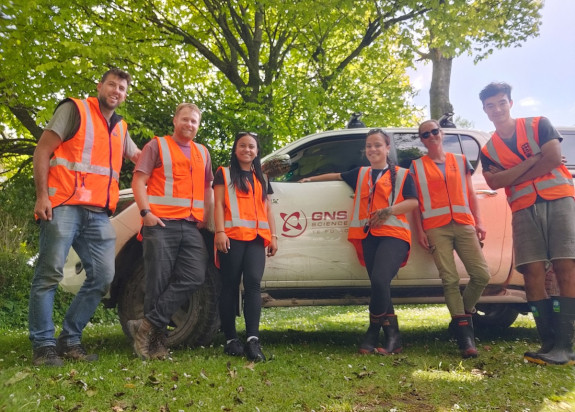Taking a passive approach to seismic vibration reading

GNS Science, in collaboration with The Australian National University, have recently deployed a novel, non-invasive technique of surveying seismic activity on the Paeroa Fault using Dense Nodal Seismic Arrays (DNSA).
An array of small devices about the size of a lunchbox are buried around about a foot deep in the soil to continuously record background vibrations in the earth. The goal of the project is to image the Northern end of the Paeroa Fault, and its strands, to better understand possible earthquake hazard that it poses.
The project is co-funded by The Natural Hazards Commission Toka Tū Ake (formerly the Earthquake Commission) with the goal of imaging the geometry of the North Paeroa fault strands to better understand earthquake hazards in the Reporoa region.
NHC’s Head of Research, Dr Natalie Balfour, says their organisation invests in research that helps New Zealanders better understand and prepare for natural hazards risks.
“This research will provide a greater awareness of how, and how often, the Paeroa Fault will rupture will support local iwi, councils, communities and lifelines to prepare for the risks and build resilience”.

The Paeroa Fault, just south of Rotorua, is one of the longest and most active faults in the Taupo Rift and is mainly surrounded by farmland making it well suited for the use of DNSA. To image the Paeroa Fault’s deeper geometry, 147 seismometers (provided by the Australian National Research Facility for Earth Sounding) were deployed for a month over a 5x5 km region spanning a segment of the main and secondary segments of the fault. Measurements will help to further understand what the fault looks like as it descends into the earth and how steeply it dips.
“Nodal seismic surveys are the future of seismic exploration, so this project provides an exciting step forward for GNS Science. We hope that data that we’ve acquired here, and the analytical methods that we apply, will provide the basis for many more such surveys in the future” said Brook Keats, Geophysicist.

Science with respect
Important to the project team was the inclusion and input of Iwi in the area particularly Ngāti Tahu-Ngāti Whaoa. The project aimed to contribute and support their aspirations towards education and employment opportunities for their rangatahi. “We value this type of research as it helps with making sound decisions for our people coming from a place of knowledge” said Michelle Phillips of Ngāti Tahu-Ngāti Whaoa
The next generation
Joining the team of scientists were two students from Ngati Tahu-Ngati Whaoa, Lexus Werahiko and Usionae Werahiko-Mita, and Ouji Kurimura, a GNS Science summer student from Otago University. This project was a great opportunity for these students to gain some experience carrying out geophysical surveys, and to learn about the Earth Sciences more broadly.

Next steps
Now that the seismometers were recollected in January, the data will be analysed by a team at GNS Science in partnership with colleagues at Australia National University to translate the vibrations recorded during the survey into a model of the seismic structure beneath the Paeroa Fault, which will in turn inform us on its subsurface geometry. These results will feed into future iterations of the National Seismic Hazard Model and provide a knowledge base to build on for additional DNSA surveys in the future.